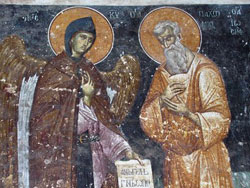St. Pachomius can be considered the founder of cenobitic monasticism, in which monks live in community. He first started out as a hermit in the desert in the third and fourth centuries, like so many Christian men and women who were trying to live out the most radical expressions of their faith.
While Pachomius was in the desert, he formed a strong friendship with Palemon, another hermit. During prayer one day, Pachomius received a vision calling him to build a monastery, and he was told that many people, who were looking for ascetic lives in the desert, but not solitude, would join him.
Pachomius and Palemon built a monastery, even though Pachomius knew his idea was radical. He opened his doors to men who were looking for austere living, but many of them had only considered solitary life. For the first years as a cenobitic, Pachomius did most of the menial work on his own, gently introducing his brother monks into a lifestyle of service to each other in the same manner.
Pachomius’ rule was said to have been given to him by an angel. St. Benedict in the west and St. Basil in the east both drew upon his rule to develop their own rules for cenobitic life.
St. Pachomius died in 346. At the time of his death, there were 11 monasteries of this kind, nine for men and two for women.

